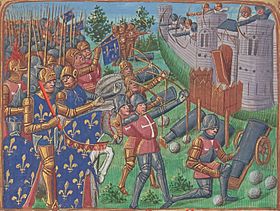Siege of Cherbourg (1450)
Quick facts for kids Siege of Cherbourg |
|||||||
|---|---|---|---|---|---|---|---|
| Part of the Hundred Years' War | |||||||
 Siege of Cherbourg, miniature from the Vigiles du roi Charles VII by Martial d'Auvergne, c. 1484 |
|||||||
|
|||||||
| Belligerents | |||||||
| Commanders and leaders | |||||||
| Thomas Gower |
|||||||
The Siege of Cherbourg was an important event in 1450. It happened during the Hundred Years' War, a long conflict between England and France. French forces surrounded the town of Cherbourg in Normandy. At this time, Cherbourg was controlled by England.
This siege took place right after a big French win at the Battle of Formigny. When Cherbourg finally fell, England lost its last major hold in Normandy. This was a huge moment that changed who controlled the region.
Contents
What Was the Siege of Cherbourg?
A siege is when an army surrounds a town or castle. They try to cut off supplies and prevent anyone from leaving or entering. The goal is to force the people inside to give up without a direct battle. The Siege of Cherbourg was one of the last sieges of the Hundred Years' War.
Cherbourg was a very important port city. It was located on the coast of Normandy. For England, keeping Cherbourg meant they still had a way to bring troops and supplies into France. For France, taking Cherbourg meant pushing the English completely out of Normandy.
Why Did the Siege Happen?
The Hundred Years' War had been going on for a very long time. By 1450, France was winning back many areas. The Battle of Formigny in April 1450 was a major victory for the French. It weakened the English forces in Normandy a lot.
After this win, the French army decided to capture Cherbourg. This was the last big English stronghold in the region. Taking it would mean the end of English rule in Normandy. It was a key step in ending the war.
Who Fought in the Siege?
The siege involved soldiers from both England and France. Each side had important leaders guiding their armies.
The English Defenders
The English forces inside Cherbourg were led by a commander named Thomas Gower. His job was to defend the town against the French attack. He and his soldiers had to hold out against the siege. They hoped for help or for the French to give up.
The French Attackers
The French army was much larger and well-organized. They had several important leaders:
- Arthur de Richemont: He was the Constable of France. This meant he was the chief commander of the French army. He led the overall strategy for the siege.
- Jean Bureau: He was a master of artillery. Artillery means big guns like cannons. Jean Bureau was very skilled at using cannons to break down walls. His cannons were a big reason for French success.
- Prigent de Coëtivy: He was another important French commander. Sadly, he was killed during the siege. This shows how dangerous sieges could be for leaders too.
How Did the Siege Unfold?
The siege began on July 6, 1450. The French army surrounded Cherbourg. They used their cannons to bombard the town's defenses. Jean Bureau's cannons were very effective. They fired heavy stone balls at the walls.
The English defenders fought bravely. However, they were outnumbered. They also knew that help was unlikely to arrive. The French kept up their attack day after day. They slowly broke down the town's defenses.
The Surrender of Cherbourg
After about five weeks, the English realized they could not hold out any longer. On August 12, 1450, Thomas Gower surrendered Cherbourg to the French. This marked the end of the siege. The French army marched into the town.
What Was the Outcome of the Siege?
The fall of Cherbourg was a huge victory for France. It meant that England no longer controlled any major territory in Normandy. This region had been under English control for many years.
This event was a major turning point in the Hundred Years' War. It showed that France was gaining strength. It also showed that England was losing its grip on French lands. The war would soon come to an end. The Siege of Cherbourg helped secure France's control over its own territory.

